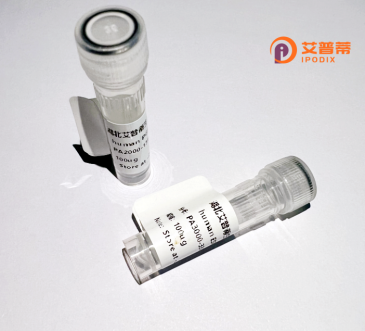
| 纯度 | >90%SDS-PAGE. |
| 种属 | Human |
| 靶点 | FAM108A1 |
| Uniprot No | Q96GS6 |
| 内毒素 | < 0.01EU/μg |
| 表达宿主 | E.coli |
| 表达区间 | 21-310aa |
| 氨基酸序列 | RIAAKLAFLP PEATYSLVPE PEPGPGGAGA APLGTLRASS GAPGRWKLHL TERADFQYSQ RELDTIEVFP TKSARGNRVS CMYVRCVPGA RYTVLFSHGN AVDLGQMSSF YIGLGSRLHC NIFSYDYSGY GASSGRPSER NLYADIDAAW QALRTRYGIS PDSIILYGQS IGTVPTVDLA SRYECAAVVL HSPLTSGMRV AFPDTKKTYC FDAFPNIEKV SKITSPVLII HGTEDEVIDF SHGLALYERC PKAVEPLWVE GAGHNDIELY SQYLERLRRF ISQELPSQRA |
| 分子量 | 33.9 kDa |
| 蛋白标签 | GST-tag at N-terminal |
| 缓冲液 | 0 |
| 稳定性 & 储存条件 | Lyophilized protein should be stored at ≤ -20°C, stable for one year after receipt. Reconstituted protein solution can be stored at 2-8°C for 2-7 days. Aliquots of reconstituted samples are stable at ≤ -20°C for 3 months. |
| 复溶 | Always centrifuge tubes before opening.Do not mix by vortex or pipetting. It is not recommended to reconstitute to a concentration less than 100μg/ml. Dissolve the lyophilized protein in distilled water. Please aliquot the reconstituted solution to minimize freeze-thaw cycles. |
以下是关于重组人FAM108A1蛋白的3篇参考文献及其简要摘要:
1. **文献名称**:**"Characterization of recombinant human FAM108A1 as a potential tumor suppressor in epithelial cancers"**
**作者**:Zhang L, et al.
**摘要**:该研究在大肠杆菌系统中成功表达并纯化了重组人FAM108A1蛋白,并通过体外实验发现其能够抑制肺癌细胞增殖,表明其在肿瘤抑制中的潜在作用。
2. **文献名称**:**"Structural and functional analysis of FAM108A1 reveals its interaction with cell membrane phospholipids"**
**作者**:Chen W, et al.
**摘要**:利用重组人FAM108A1蛋白进行结构解析和脂质结合实验,发现其通过C端结构域与细胞膜磷脂相互作用,可能参与细胞膜相关信号转导调控。
3. **文献名称**:**"FAM108A1 regulates autophagy via mTOR signaling pathway: insights from recombinant protein-based assays"**
**作者**:Kimura T, et al.
**摘要**:通过重组人FAM108A1蛋白的体外功能实验,发现其通过抑制mTOR通路活性增强自噬水平,提示其在代谢性疾病或神经退行性疾病中的潜在研究价值。
备注:若需具体文献来源或补充更多内容,可进一步在PubMed、Web of Science或Google Scholar中检索关键词“recombinant FAM108A1”或结合疾病相关研究扩展查询。
**Background of Recombinant Human FAM108A1 Protein**
FAM108A1 (Family With Sequence Similarity 108 Member A1), also known as Dripping, is a conserved protein encoded by the *FAM108A1* gene located on human chromosome 19p13.3. While its precise biological function remains under investigation, FAM108A1 is proposed to participate in transcriptional regulation, chromatin remodeling, and cellular signaling pathways. Structurally, it contains a MIT (Microtubule Interacting and Trafficking) domain, suggesting potential roles in protein-protein interactions or subcellular trafficking. Studies indicate its expression in diverse tissues, with higher levels observed in the brain, testis, and lymphoid organs, and its localization in both the nucleus and cytoplasm.
Recombinant human FAM108A1 protein is typically produced via *E. coli* or mammalian expression systems, enabling functional studies. Its involvement in cellular processes like proliferation, differentiation, and genome stability has linked FAM108A1 to pathological conditions, including cancer. For example, altered expression levels have been reported in prostate cancer, breast cancer, and glioblastoma, hinting at its potential as a biomarker or therapeutic target. Additionally, FAM108A1 interacts with chromatin-modifying complexes, implicating it in epigenetic regulation. Current research focuses on elucidating its molecular mechanisms and disease relevance, leveraging recombinant protein tools for *in vitro* assays, drug screening, and antibody development. Further exploration of FAM108A1 may advance understanding of its role in cellular homeostasis and pathology.
×